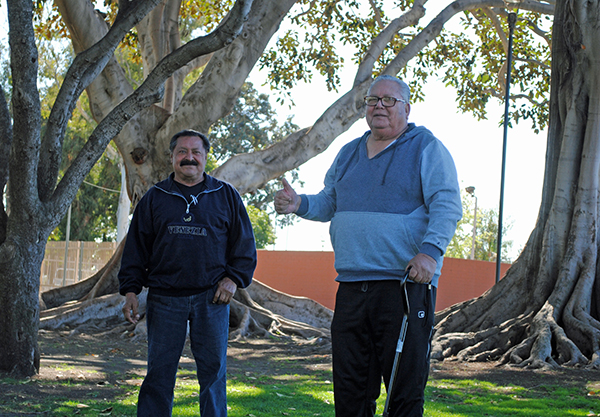By Alfredo Santana
Contributing Writer
BELL GARDENS — A battle to save up to 31 trees at John Anson Ford Park is brewing as residents vowed to push back against city plans to cut down the trees to make way for an expanded million aquatics center.
Public Works Director Grissel Chavez said the trees are a combination of crape myrtles, queen palms, laurels and eucalyptus, with the oldest being between 25 and 35 years of age.
Chavez confirmed that four eucalyptus trees are on the chopping block, with two located on the projected aquatic center’s south side near a small children’s playground next to the restrooms.
“Those are the biggest, oldest trees being removed,” Chavez said. “None of the other trees around the pond or other areas of the park are being removed. Just those directly behind the aquatics center, the four behind where the playground is located in that grass area.”
The youngest trees are 5 to 10 years old.
Chopping down trees at the park does not sit well with longtime visitor Jose Carbajal.
He warned city officials that he would start a drive to gather signatures from city residents, pedestrians and park visitors to stop construction if large trees spotted on the southeast corner of the aquatics complex remain on the chopping list.
Carbajal, a retiree from neighboring Downey, said he enjoys the calm atmosphere and fresh breeze at the park. He visits about three times a week to have lunch, chat with friends or to unwind from a stressful day.
“I come here to enjoy the park, the picnic areas and its beautiful trees,” Carbajal said as he signaled toward the large trees with roots above the ground. “If they go on with their plans to remove them, we will raise a stink.”
Likewise, Bell Gardens resident Fernando Aguilar said many first-time enjoy the large trees.
“A lot of people come and I’ve heard them say ‘look, how beautiful those trees are.’ They come from far away places, from East Los Angeles, even from the MacArthur Park neighborhood just to enjoy this park,” Aguilar said. “We don’t want to see these trees go wasted.”
Aguilar supports the aquatic center’s renovation and expansion project, but vowed to fight to preserve tall old trees that offer wide shade.
The city should encourage preservation of existing trees and planting more, not wiping them out, Aguilar said. “The aquatics center is, in principle, good. But please, do not mess with the trees. They are the park’s attraction. They are appreciated.”
At a recent public meetings, Bell Gardens City Councilman Marco Barcena pressed his colleagues to push for a fast teardown and renovation of the expanded aquatics center, but did not address cutting down trees.
Before the tree issue became public, a string of financial hurdles and lack of permits bogged down deconstruction of the old aquatics center.
The city had planned to start removing items like an old fuel tank before it demolishes the swimming pool this summer, only if a $17 million loan petition filed with the U.S. Housing and Urban Development Department is approved.
A local hearing on the so-called Section 108 Community Development Building Block loan had been planned for this month.
Also, Bell Gardens secured a $6 million federal grant last September, but it is frozen until the National Park Service issues a notice to proceed with construction work.
Another potential delay is tied to the relocation of a satellite maintenance yard at the park’s south end, estimated to cost $3.2 million.
Gabriela Gomez, a Bell Gardens native who was 8 years old when she began swimming at the park pool, said she expects the city to unveil a plan to replace the trees targeted for axing with an equal number of the kind.
Walking along her niece’s tricycle and her mother’s walker on a cemented path, Gomez said she supports the idea of renovating the aquatics center to offer youth an expanded facilities where they can exercise and stay fit.
“I can’t imagine that [the city] would expand the aquatics center without a plan to replace the trees,” she said.
Gomez recalled that years ago, several trees along the parking lot used to drop a thick, sticky substance on top of cars when their fruit ripened.
After complaints poured in from visitors to park maintenance workers, the city opted to get rid of the trees, she said.
A few yards away, Madison Lopez played with her toddler in the children’s playground nested on the aquatic center’s southwest corner, while three adult geese plucked grass with their beaks.
Lopez did not like the idea that trees could be chopped down to make room for three new swimming pools.
“To swap trees for pools that would serve a recreational purpose, that is illogical,” Lopez said. “My son loves the ducks and we came here to enjoy the trees. If they cut the trees, they would also cut the park’s wildlife. The ducks will go out next.”
If the city does not modify its stance, and a campaign to save the park’s current trees is launched, Lopez said she will sign it.
Chavez did not return phone calls requesting comment on whether the city would replace the trees listed for axing.












